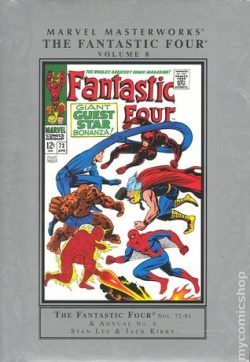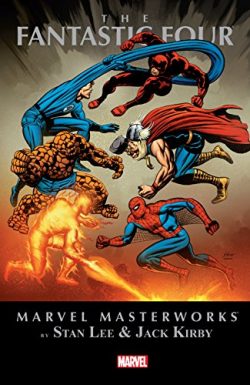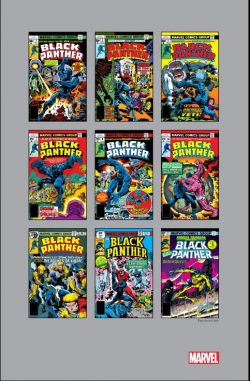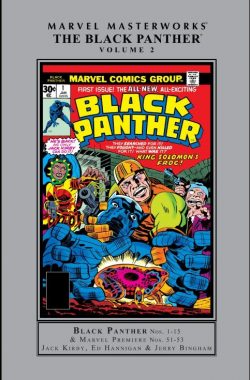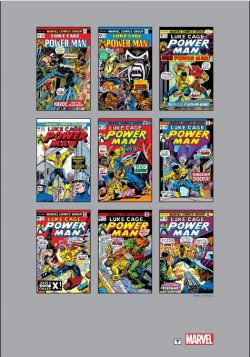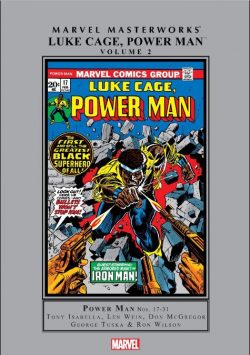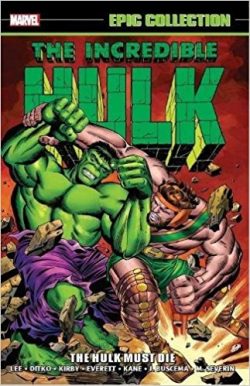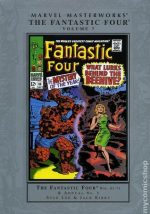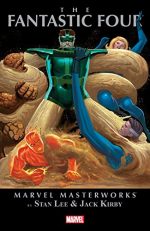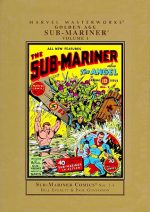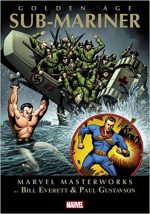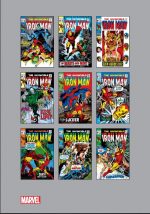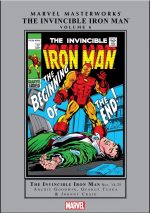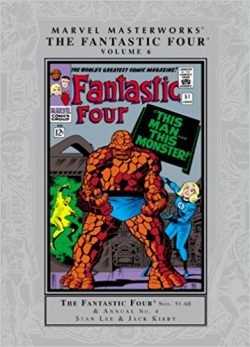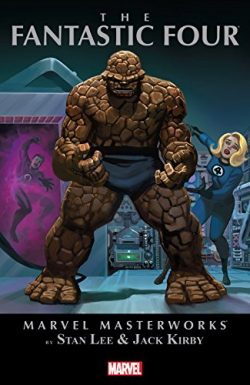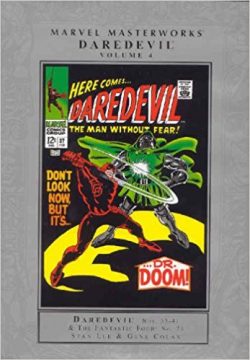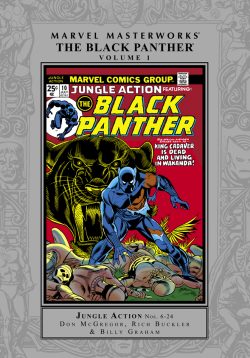
By Don McGregor, Rich Buckler, Gil Kane, Billy Graham, Keith Pollard, Klaus Janson & various (Marvel)
ISBN: 978-0-7851-4198-3 (HB)
Acclaimed as the first black superhero in American comics and one of the first to carry his own series, the Black Panther‘s popularity and fortunes have waxed and waned since his debut.
In fact, the cat king actually attacked Marvel’s First Family as part of an extended plan to gain vengeance on the murderer of his father. He was also the first black superhero in American comics, catapulting to instant fame and glory in Fantastic Four #52 (cover-dated July 1966).
As created by Jack Kirby & Stan Lee, T’Challa, son of T’Chaka, is an African monarch whose clandestine domain is the only source of vibration-absorbing wonder mineral Vibranium. The miraculous alien metal – supposedly derived from a fallen meteor which struck the continent in lost antiquity – is the basis of the country’s immense wealth, enabling Wakanda to become one of the wealthiest and most secretive nations on Earth. These riches also allowed the young king to radically remake his country, creating a technological wonderland even after he left Africa to fight as one of the mighty Avengers.
For much of its history Wakanda has been an isolated, utopian kingdom with the tribal resources and people safeguarded and led since time immemorial by a human warrior-king deriving cat-like physical advantages from secret ceremonies and a mysterious heart-shaped herb. This has ensured the generational dominance of the nation’s Panther Cult and Royal Family…
The top-secret “Vibranium mound†had guaranteed the country’s status as a clandestine superpower for centuries but in modern times has increasingly made Wakanda a target for subversion, incursion and even invasion as the world grew ever smaller.
After wandering around the Marvel Universe, enjoying team-ups and saving the world on a semi-regular basis as one the “Earth’s Mightiest Superheroesâ€, in the summer of 1973 the Black Panther finally won his own solo series, Scripter Don McGregor opted to return the King to his people for an ambitious epic of love, death, vengeance and civil war: inventing from whole cloth, and Kirby’s throwaway notion of a futuristic jungle, the most unique African nation ever seen…
Gathering the groundbreaking stories from Jungle Action volume 2 #6-24 (spanning September 1973 to November 1976 and available in hardback and digital formats), the saga opens with an erudite and informative Introduction by Don McGregor.
‘Panther’s Chronicles’ discusses the author’s work practises, close relationship with his artistic collaborators, and the cultural context and milieu surrounding the creation of the series at a time when segregation and civil rights were still a hot button topic in America…
Now with the Panther’s own big-budget big-screen blockbuster imminently expected, the long-lauded, brilliantly effective and fantastically poetic work of Don McGregor and his collaborators can be enjoyed as the groundbreaking narrative landmark it is, free of the torturous months-long wait between cliff-hanging chapters…
Jungle Action launched with an October 1972 cover-date, a cheap reprint vehicle for old Atlas-era Tarzan and Sheena knock-offs like Tharn, Jann and Lorna (…of the Jungle). The fifth issue abruptly changed tack, reprinting the Black Panther-starring contents of Avengers #62 as prelude to the start of T’Challa’s own all new adventures, which open here with #6 and the eponymous ‘Panther’s Rage’ illustrated by Rich Buckler & Klaus Janson.
The story opens with the Panther back in his African homeland and stumbling upon the torture of an elderly farmer. Despite his best efforts the victim dies in his arms, swearing he never lost faith in king or country…
Learning the attack is the work of a mysterious, brutal rebel leader named Erik Killmonger, T’Challa sets all the resources of his inner court circle to finding the monster. With reports of further atrocities mounting, he leaves his American lover Monica Lynne to hunt the perpetrators and soon confronts his potential usurper at the potently symbolic Warrior Falls roaring above the life-sustaining River of Grace and Wisdom.
The barbarous-seeming giant is not cowed by the Panther’s power or prowess and easily wins the no-holds barred battle that follows…
The initial episode is supplemented by detailed maps of Wakanda (the first fans had ever seen) before JA #7 mobilises ‘Death Regiments Beneath Wakanda’. Barely surviving his fight with Killmonger, T’Challa is nursed back to health by Monica at the Palace even as hideously disfigured American Horatio displays his skill with snakes and poisons to his friend N’Jadaka.
Known to their recruits as Venomm and Erik Killmonger, these rebel leaders plot their next attack which results in the reptilian insurgent ambushing T’Challa when the king investigates an illegal mine. This shocking atrocity is being used to siphon off raw Vibranium to pay for Killmonger’s increasingly violent and widespread attacks on the outlying population centres…
Although triumphant this time, T’Challa realises this is many-layered war: one he might not win…
Cover-dated January 1974, Jungle Action #8 introduced another super-powered rebel as – whilst the Black Panther renews his powers through ancient ritual – ‘Malice by Crimson Moonlight’ sees a spear-wielding wonder woman invade the Royal Palace.
Advisor Taku is interrogating Venomm and gradually making inroads into turning the bitter outcast when Malice attacks. Only the power of the Panther saves him and prevents the brutal jailbreak from succeeding…
After more maps of the hidden country and detailed plans of ‘Central Wakanda’s Palace Royale’ the saga resumes in #9 with ‘But Now the Spears Are Broken’ (illustrated by Gil Kane & Janson) as T’Challa goes in-country to learn the effects of the power-struggle on ordinary Wakandans.
After saving little boy Kantu from a rhino, the king is made painfully aware that the common people view his foreign woman Monica with as much suspicion as the constantly-raiding insurgents. That feeling even penetrates to the heart of the palace. When advisor Zatama is murdered, Monica is arrested for the crime…
T’Challa is not there to protest or defend her: he has returned to Kantu’s village to investigate strange disappearances, discovering a seeming mass-rising of zombies led by a skeletal maniac called Baron Macabre. Once more the Great Cat is forced to ignominiously retreat…
Supreme stylist Billy Graham takes over the pencilling with #10 as the Black Panther returns to the zombie nest, exposing a cunning charade beneath the deserted village as well as a super-scientific base run by a malignant, mind-warping mutant in ‘King Cadaver is Dead and Living in Wakanda!’
Accompanying the dark drama here are examples of ‘Black Panther Artistry’: specifically, Kirby’s first designs for the hero back when he was going by the provisional title of ‘The Coal Tiger’ and Buckler and Janson’s first depiction of ‘Erik Killmonger’…
Due to an extremely unfavourable publishing schedule, Panther’s Rage unfolded with agonising slowness, but the lengthy wait between episodes allowed McGregor the latitude to pick and choose key events, with readers accepting that some stuff was actually occurring between issues.
In #11 (September 1974), the civil war had proceeded unchecked and ‘Once You Slay the Dragon!’ sees the Panther and his forces launching a long-awaited counterattack on Killmonger’s base in N’Jadaka Village. The battle is vicious and brief, introducing yet another powered lieutenant in the shape of pitiless high-tech armourer Lord Karnaj…
And on the home front, T’Challa finally clears Monica and captures Zatama’s killer…
With Killmonger temporarily pushed back, the Panther goes on the offensive, using the rebel’s most inconsequential converts – Tayete and Kazibe – as guides to follow his ultimate enemy to his most secret strongholds. Heading into the mountains and the fabled Land of Chilling Mists, the Panther discovers mutagenic temple the Resurrection Altar.
Used by Killmonger to create his grotesque super-warriors, it is presided over by scientifically-spawned vampire Sombre. When T’Challa confronts them, he is again overpowered by Erik and left for the wolves to devour in ‘Blood Stains on Virgin Snow!’
Craig Russell inked the next chapter as, enduring incomprehensible hardships in sub-arctic conditions, T’Challa perseveres to follow Killmonger into the temperate swamps of Serpent Valley in #13.
However, this is only after facing a pack of Wakanda’s white apes. To survive, the Panther must blasphemously ignore the sacred religious aspect of the mighty carnivores and become ‘The God Killer’…
Following a Venomm pin-up, JA #14 reveals that ‘There Are Serpents Lurking in Paradise’ (inked by Pablo Marcos) as T’Challa again clashes with Sombre and encounters an affable forest sprite guarding Serpent Valley. Pixie-like Mokadi asks difficult moral questions as T’Challa rushes towards his next battle with Killmonger, making him too late to stop the rebel capturing a legion of the valley’s awesome dinosaurs. The usurper even has time to leave one behind as a lethal parting gift for the embattled Wakandan chieftain…
The endgame rapidly approached in #15 as ‘Thorns in the Flesh, Thorns in the Mind’ (inked by Dan Green) finds T’Challa tracking his nemesis only to be overcome by Killmonger’s archer assassin Salamander K’Ruel and left to be dismembered by a ravenous Pterosaur before – against all odds – staggering back to Monica for another bout of recuperation…
Graham inked his own pencils for the beginning of the end in #16 as T’Challa and Monica’s time of idyllic passion culminates in catastrophe when ‘And All Our Past Decades Have Seen Revolutions!’ reveals the origins of Killmonger and sees the vast cast all converge for one final battle…
That comes in #17 as an army of war-trained dinosaurs invades Central Wakanda only to be finally crushed by the Panther’s forces and superior technology. The affair concludes as it began at Warrior Falls, but ‘Of Shadows and Rages’ also holds a shocking twist as the great game of kings is decided by a player no one considered of any relevance…
With its nuanced emotional interplay, extended scope and fiercely independent supporting cast, Panther’s Rage was a milestone in dramatic comics storytelling but it harboured one last punch in a gripping ‘Epilogue!’ (Jungle Action #18, November 1975). Bob McLeod inked McGregor & Graham’s forceful look at the repercussions of conflict as T’Challa and maimed security chief Wakabi are targeted by feral woman Madame Slay: Killmonger’s ardent and unsuspected lover who believes her loss can only be assuaged by having her pack of loyal leopards eviscerate the victorious Wakandans…
Cover-dated January 1976, Jungle Action #19 opened McGregor’s most audacious and ultimately frustrating project, as T’Challa accompanies Monica back to America. The Panther versus the Klan shifted focus from war stories to detective fiction, replacing fabulously exotic Africa for America’s poverty-wracked, troubled Deep South and a head-on collision with centuries of entrenched and endemic racism.
Illustrated by Graham & McLeod, ‘Blood and Sacrifices!’ sees Monica reunite with her family after her sister is murdered. All too soon T’Challa is battling a gang of purple-hooded killers who appear to have set up in opposition to the ancient white-hooded Ku Klux Klan. Moreover, both sects seem determined to conceal the truth of Angela Lynne’s death…
A break comes when bumbling, well-meaning reporter Kevin Trublood stumbles into an attack on the newcomers by the strangely multi-racial Klan sect calling itself the Dragon Circle…
With neither townsfolk nor lawmen offering any welcome, T’Challa faces unbridled hostility and suspicion at every turn. He is even attacked by cops and a mob of citizens when he thwarts a knife attack on Monica. Although Sheriff Roderick Tate makes all the right noises and seems helpful, in ‘They Told Me a Myth I Wanted to Believe’, the Panther opts to pursue his own investigation before being overwhelmed by an army of white-robed Klansmen who tie him to a burning cross and leave him to die…
As Monica and Kevin puzzle out the convoluted web of mysteries, the Panther exerts all his gifts to escape becoming ‘A Cross Burning Darkly Blackening the Night!’ Later, as he slowly recovers in hospital, the family, Kevin and Tate review the few verifiable facts of Angela’s demise before patriarch Lloyd Lynne urges T’Challa to stop looking. He only has one daughter left after all…
Nevertheless, when the Panther and Trublood invade and disrupt a Klan rally, Lloyd is right there with them…
With Rick Buckler joining Graham on pencils and Jim Mooney alternating with McCleod on inks, Jungle Action #22 takes a bizarre turn as ‘Death Riders on the Horizon’ explores a Lynne family legend dating back to the formative days of the Klan in 1867 when old Caleb was targeted by the vile southern knights and their seemingly supernatural sponsor the Soul Strangler. As Monica listens to the ghastly, appallingly unjust tale, her mind fills in how T’Challa would have acted in such a hopeless situation…
Issue #23 (September 1976) was a deadline missed and a rapidly-sourced reprint from Daredevil #69 – represented here only by the pertinent cover and a Buckler pin-up – before this tantalising tale is unhappily cut short in final published instalment ‘Wind Eagle in Flight’ (by McGregor, Buckler & Keith Pollard).
The multi-layered, many-stranded plot suddenly expands as the Black Panther is almost killed by a mysterious new player who flies into the ever-more bewildering clash between cops, Klan, Dragon Circle and Lynne family, but, before the mystery could move any further, Jungle Action was cancelled…
A wholly different kind of Black Panther and utterly unrelated adventures would reappear two months later, under the auspices of returning creative colossus Jack Kirby. It would be years before the enigma of Angela’s death and the hero’s war against the Klan would be resolved…
So that’s what to look forward to in the next volume…
Here, however, a passionate reminiscence and appraisal follows in an ‘Afterword by Dwayne McDuffie’, as well as John Romita’s cover for Jungle Action #5; original cover art, pages and sketches by Buckler & Janson and Kane; pencils and layouts by Graham and Buckler as well as Steve Gerber’s ‘Jungle Re-Actions’ feature from JA #7, plus the un-inked Buckler story pages that would have been #25.
Also included are McGregor’s correspondence with then-fan Ralph Macchio and the author’s original working notes, plot synopses and candid contemporary photos of the close-knit creative team.
A truly bold masterpiece of comics narrative, Don McGregor’s Black Panther is stark, vibrant proof that the superhero genre works best when ambitious and passionate creators are given their head and let loose to get on with it. Now, supported by a major movie, perhaps readers will finally see how the Fights ‘n’ Tights game should be played…
© 1973, 1974, 1975, 1976, 2016 Marvel Characters Inc. All rights reserved.
